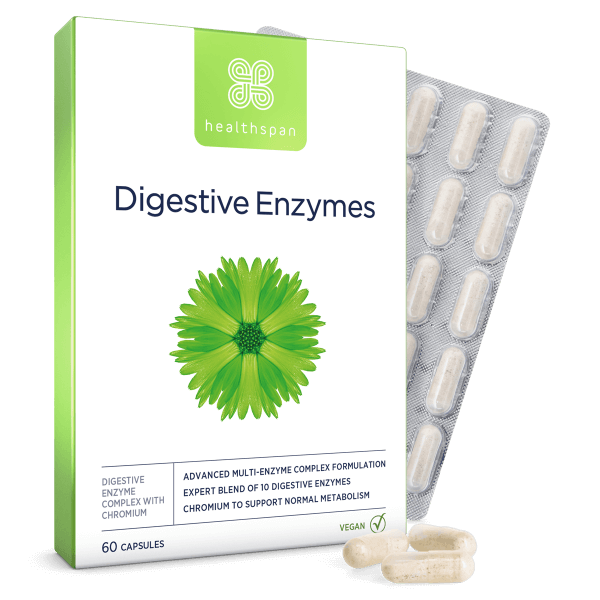Digestion turns the food we eat into nutrients our bodies can absorb. Digestive enzymes are essential for this process. But what are they and could you benefit from taking a supplement?
🕒 9 min read
Some 37 billion trillion biochemical reactions take place in our bodies every second. Such a staggering number requires a huge amount of energy. Enzymes help our cells conserve that energy by speeding up the rate at which biochemical reactions take place.
What are digestive enzymes?
Digestive enzymes help our body use nutrients found in food by breaking down larger molecules into smaller, more absorbable ones. In this way they play a key role in the digestion, absorption, and metabolism of carbohydrates, fats, and proteins.
Several factors affect the production of digestive enzymes. These include diet, genes, age, body mass index (BMI), and body clock (circadian rhythm) as well as the composition of our gut microbiota – the bacteria in our gut.
Where do digestive enzymes come from – and what happens if I don't have enough?
Digestive enzymes are made in various parts of our digestive system including the mouth, the stomach, the pancreas and the small intestine. When digestive enzymes are made and secreted in the right quantity we don't normally notice the process of digestion.
Insufficient digestive enzymes, however, can lead to digestive problems including bloating, wind, indigestion, heartburn, flatulence, abdominal pain or cramps, diarrhoea and loose, greasy or unpleasant-smelling stools.
Enzymes in the body
We have around 75,000 enzymes in our bodies, involved in a host of actions from digestion to breaking down toxins in the liver, producing hormones, replicating DNA, regulating the actions of our cells and more.
Doctors also use enzymes in blood tests to diagnose a variety of diseases and to help determine prognosis and the likely response to treatment. For example, the cardiac enzyme troponin is used to diagnose heart attack. Meanwhile high levels of digestive enzymes called lipases can be a sign of pancreatitis (inflammation of the pancreas.)
Food sources of digestive enzymes
Other enzymes that work in the same way are found in fruit, vegetables and fungi. Proteases, for example, that help digest protein, are found in papaya (papain), kiwifruit (actinidin), pineapple (bromelain), mango (amylase), ginger (zingibain), and figs (ficin/ficain). Lipase, which helps digest fats, is found in avocados.
Meanwhile, cellulases, found in fungi, which break down a type of fibre called cellulose, are found in fruit, veg, pulses, wholegrains, nuts, seeds and other plant foods. Including some of these in your diet may aid digestion.
Common digestive enzymes at a glance
| Name | Site of production | Action | Other information |
| Amylase | Salivary glands, pancreas. | Breaks down complex carbohydrates (starches) into simpler sugars. | |
| Lactase | The 'brush' border of the small intestine (so called because it contains thousands of tiny projections like the bristles of a paintbrush.) | Breaks down lactose, a type of sugar found in dairy foods including whole milk, yoghurt, buttermilk, coffee creamer, sour cream, kefir as well as some medications. | |
| Lipase(s) | Mouth, pancreas, stomach. | Break(s) down fats into fatty acids. Pancreatic lipases aid the absorption of fat-soluble vitamins such as vitamin D. | Other lipases are found in the liver, fat cells and the inner lining of blood vessels. |
| Protease(s) | Stomach (e.g. pepsin), pancreas (e.g. trypsin, chymotrypsin and carboxypeptidase), small intestine (e.g. activated trypsin.) | Break(s) down proteins. | Other proteases are involved in blood clotting, cell division, recycling proteins and supporting the immune system. |
| Sucrase | Small intestine (intestinal villi.) | Breaks down sucrose, the type of sugar found in many fruit, vegetables and other plant foods, table sugar, and sweets. |
The anti-obesity drug orlistat works by blocking pancreatic lipase and reducing fat absorption. Some cholesterol-lowering medications also work by acting on lipases.
What affects the production of digestive enzymes?
Some common factors include the following:
- As we get older the production of digestive enzymes tends to diminish. Saliva flow can become sluggish, leading to fewer digestive enzymes being produced in the mouth.
- Atrophic gastritis. Inflammation of the stomach lining, which becomes more common as we get older, can destroy the glands that make gastric acid and digestive enzymes. Secretion of the protease pepsin also declines after we hit 70. Helicobacter pylori (H.pylori), the bacterium that causes stomach ulcers, is a key cause of gastritis and is thought to affect 40-75% of older people.
- Lactose intolerance. A complete lack of lactase (alactasia) or a short supply (hypolactasia), is another factor. When this occurs lactose (milk sugar) enters the colon undigested, leading to classic symptoms of lactose intolerance such as abdominal pain, flatulence, gas, bloating, and diarrhoea.
- Pancreatic insufficiency (exocrine pancreatic insufficiency or EPI.) A shortage of pancreatic hormones that is more prevalent with age, it affects more men than women and is more common in smokers. One study found that people over the age of 65-70 years had significantly reduced amounts of pancreatic enzymes compared with younger participants. Symptoms include pale fatty stools that float, abdominal discomfort, bloating, and weight loss.
- Functional dyspepsia. The medical term for chronic indigestion with no clear cause, with symptoms including stomach pain or burning, bloating, belching, nausea and feeling full soon after eating. Digestive enzyme supplementation has been found to ease symptoms and improve quality of life and sleep.
- Digestive disorders. Crohn's disease (CD), ulcerative colitis (UC), coeliac disease, cystic fibrosis, chronic pancreatitis and conditions affecting the pancreas, as well as gastrointestinal surgery, can all affect digestive enzyme production. You should be under medical care for these conditions.

Digestive Enzymes
For digestion and metabolism support
- Expertly formulated blend of naturally occurring digestive enzymes
- Including amylase, bromelain, lactase, lipase and protease
- Aids digestion of carbohydrates, lactose, proteins and fats
Should I take a digestive enzyme supplement?
If you frequently experience indigestion, a digestive enzyme supplement could help. For example, if you are lactose intolerant or find dairy products hard to digest, lactase enzyme tablets or a supplement containing lactase enzyme could help. If you find digesting vegetables a problem, a supplement containing cellulases, which help break down cellulose, a type of plant fibre, could fit the bill.
Choosing and using digestive enzymes
- Look for enzyme activity in FCC (Food Chemical Codex) units. This is the industry standard for establishing the activity levels of plant enzymes, and shows the amount of activity of each enzyme. Those with the highest individual activity unit are the most active.
- Steer clear of products that simply list the weight of enzymes (e.g. in micrograms), as these reveal nothing about their activity.
- Look for a supplement with a range of different proteases. Different proteolytic enzymes act optimally at different pH levels, and pH varies along the digestive tract. If you see a number, such as 'protease (4.5)', this relates to the optimal pH of that specific enzyme.
- Vegetarian or vegan? The enzymes used in digestive enzyme supplements mainly come from plant sources such as fungi, but double-check to make sure.
- Take digestive enzymes at the beginning of a meal, as they need to work with food to enhance digestion.
- A second dose may occasionally be needed if you are eating a heavy meal, such as when eating out.
- Avoid taking antacids or indigestion remedies within two hours of taking digestive enzymes. These may reduce the enzymes' effectiveness.
- Take enzymes according to the instructions on the pack. If symptoms don't improve within two weeks seek medical advice.
NOTE: If you are taking prescribed medication, are pregnant, breastfeeding, or have a medical condition, consult a healthcare professional before taking digestive enzymes.
Digestive enzymes are available on prescription for people with clinically diagnosed enzyme insufficiency, such as those with cystic fibrosis or frequent pancreatitis. In these cases the doctor may prescribe PERT (pancreatic enzyme replacement therapy) with amylase, lipase and protease to aid the breakdown of carbohydrates, fats and proteins.
Current research is examining the role of digestive enzymes for treating IBS (irritable bowel syndrome), and in particular diarrhoea-predominant IBS. Around 5% of sufferers have been found to be deficient in pancreatic enzymes. A study found that after PERT, patients had significantly improved stool frequency, stool consistency, abdominal pain, distension and IBS severity score.
Can I take digestive enzymes with other supplements?
It's fine to take digestive enzymes alongside, for example, a multivitamin and mineral supplement. In fact, doing so can help you to absorb these nutrients more efficiently. It's also fine to take them with probiotics.
In fact, some digestive enzyme supplements contain a combination of digestive enzymes, probiotics and vitamins, all working together to enhance absorption and improve digestion. For example, chromium in a digestive enzyme supplement helps to support the metabolism of carbohydrates, protein and fats.
The mouth. Digestive enzymes start to act as you take the first bite of food. As you chew, the salivary glands secrete saliva. Saliva releases amylase, which breaks up big starch molecules from starches found in foods like potatoes, bread, rice and pasta, into smaller sugar molecules. It also releases lipase, which starts breaking down fats from things like butter, oils and fatty foods.
The stomach. The now ball-like mixture of chewed food and saliva, called a bolus, passes into the stomach, where your digestive juices get to work. These include hydrochloric acid, an extremely strong acid that breaks down food and kills any stray bacteria; pepsin, which breaks down proteins from foods such as meat, dairy, nuts, and seeds, into chains of amino acids (peptides); and lipase, which continues breaking down fat.
The small intestine. The partially digested food, now called chyme, leaves the stomach and enters the first part of the small intestine, the duodenum, where it encounters digestive juices in the form of bile from the gallbladder and digestive enzymes from the pancreas, which work together to continue digestion.
- Bile, made in the liver and stored in the gallbladder, breaks down fats into fatty acids.
- Amylase, made in the pancreas, breaks down starch into different kinds of sugars, while pancreatic lipase breaks down fat.
- Trypsin, a protein made in the pancreas in an inactive form, is converted to an active form and released into the duodenum, where it continues breaking down protein. Another related pancreatic enzyme, chymotrypsin, helps this process.
- Pancreatic lipase continues to break down fat and fat-soluble vitamins.
The remains of our meal now enter the rest of the small intestine, where the final stage of carbohydrate and protein digestion occurs. Here more digestive enzymes are released. These include lactase, maltase, and sucrase-isomaltase – three enzymes that continue breaking down sugars – as well as peptidase, a proteolytic enzyme.
These enzymes complete chemical digestion, enabling nutrients to be absorbed via the small intestine into the bloodstream. The work of our digestive enzymes is done.
The large intestine. Any undigested food is pushed into the large intestine (colon), which contains no digestive enzymes. Here water, minerals and any remaining nutrients are absorbed and any remaining waste is excreted.







